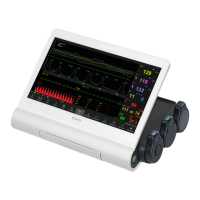F15 Series Fetal & Maternal Monitor User Manual WI-FI Networking and Instructions
- 168 -
Appendix 8 Limitations of Ultrasonic Monitoring
A8.1 How Does Ultrasound Work
When the ultrasound waves strike an object, they bounce back and create an echo. If the object
moves toward the sound source, the frequency of the echo increases. If the object moves away from
the sound source, the frequency of the echo decreases. This is called “Doppler Effect”. In the 1960's,
the ultrasonic technique was first applied to medical diagnostic imaging.
The ultrasound process involves placing a small device called a transducer, against the skin of the
patient near the region of interest. The ultrasound transducer combines functions of emitting and
receiving ultrasounds in one device. This transducer produces a stream of inaudible, high frequency
sound waves which penetrate into the body and bounce off the organs inside. It detects sound waves
as they bounce off or echo back from the internal structures and contours of the organs. The
movement of the organs produces the Doppler Effect, and this movement can be measured and
described by measuring the echo.
In fetal monitoring, the ultrasound transducer produces a stream of sound waves which penetrate into
the maternal abdomen and bounce off the fetal heart. Then the transducer receives the echoes and
transfers them to the monitor, which turns the signal into fetal heart beating sound and fetal heart rate
trace.
Therefore, placement of the transducer is critical to ultrasound fetal heart monitoring.
A8.2 Artifacts in Fetal Heart Monitoring
(1) How does artifact happen?
The transducer detects sound waves as they bounce off or echo back from the fetal heart. However,
the sound waves bouncing off from maternal blood vessels may be detected by the transducer and
then be processed by the monitor as well. As a result, artifacts may be produced.
The artifacts, if not correctly interpreted, may cause the physicians to perform unnecessary
interventions, or to fail to detect the fetal distress and the need for interventions.
The most common artifacts are doubling, halving, erratic traces / drop out and switching to maternal
heart rate.
(2) Doubling:
When the FHR drops to 120 bpm or lower, the diastole and systole become far apart, thereby the
monitor may mistake these two movements of a single heartbeat for two separate heartbeats. As a
result, a heart rate trace that is double the actual heart rate is produced. This often happens during
severe decelerations and bradycardia, representing an abrupt switch of the trace to double the actual
heart rate.
Traditional 510(k) of Fetal & Maternal Monitor
014_14.1_F15_Series_User_Manual

